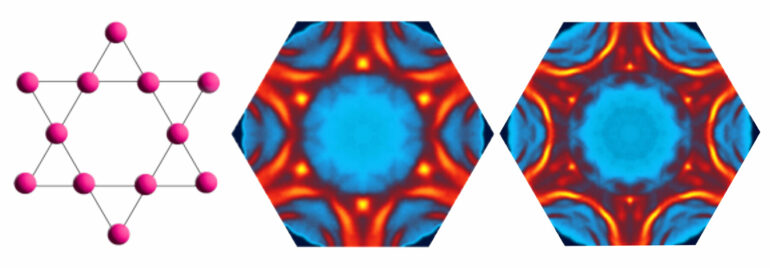Physicists were surprised by the 2022 discovery that electrons in magnetic iron-germanium crystals could spontaneously and collectively organize their charges into a pattern featuring a standing wave. Magnetism also arises from the collective self-organization of electron spins into ordered patterns, and those patterns rarely coexist with the patterns that produce the standing wave of electrons physicists call a charge density wave.
In a study published this week in Nature Physics, Rice University physicists Ming Yi and Pengcheng Dai, and many of their collaborators from the 2022 study, present an array of experimental evidence that shows their charge density wave discovery was rarer still, a case where the magnetic and electronic orders don’t simply coexist but are directly linked.
“We found magnetism subtly modifies the landscape of electron energy states in the material in a way that both promotes and prepares for the formation of the charge density wave,” said Yi, a co-corresponding author of the study.
The study was co-authored by more than a dozen researchers from Rice; Oak Ridge National Laboratory (ORNL); SLAC National Accelerator Laboratory; Lawrence Berkeley National Laboratory (LBNL); the University of Washington; the University of California, Berkeley; Israel’s Weizmann Institute of Science; and China’s Southern University of Science and Technology.
The iron-germanium materials are kagome lattice crystals, a much-studied family of materials featuring 2D arrangements of atoms reminiscent of the weave pattern in traditional Japanese kagome baskets, which features equilateral triangles that touch at the corners.
“Kagome materials have taken the quantum materials world by storm recently,” Yi said. “The cool thing about this structure is that the geometry imposes interesting quantum constraints on the way the electrons are allowed to zoom around, somewhat analogous to how traffic roundabouts affect the flow of traffic and sometimes bring it to a stop.”
By nature, electrons avoid one another. One way they do this is to order their magnetic states—spins that point either up or down—in the opposite direction of their neighbors’ spins.
Dai, a co-corresponding study author, said, “When put onto kagome lattices, electrons can also appear in a state where they are stuck and cannot go anywhere due to quantum interference effects.”
When electrons cannot move, the triangular arrangement produces a situation where each has three neighbors, and there is no way for electrons to collectively order all neighboring spins in opposite directions. The inherent frustration of electrons in Kagome lattice materials has long been recognized.
Yi said the lattice restricts electrons in ways that “can have a direct impact on the observable properties of the material,” and the team was able to use that “to probe deeper into the origins of the intertwinement of the magnetism and charge density wave” in iron-germanium.
They did so using a combination of inelastic neutron scattering experiments, which were performed at ORNL, and angle-resolved photoemission spectroscopy experiments that were performed at LBNL’s Advanced Light Source and SLAC’s Stanford Synchrotron Radiation Lightsource, as well in Yi’s lab at Rice.
“These probes allowed us to look at what both the electrons and the lattice were doing as the charge density wave was taking shape,” she said.
Dai said the findings confirmed the team’s hypothesis that charge order and magnetic order are linked in iron-germanium. “This is one of the very few, if not of the only, known example of a kagome material where magnetism forms first, preparing the way for charges to line up,” he said.
Yi said the work shows how curiosity and basic research into natural phenomena can eventually lead to applied science.
“As physicists, we are always excited when we find materials that spontaneously form an order of some sort,” she said. “This means there is a chance for us to learn about the self-organizational abilities of the fundamental particles of quantum materials. Only with that kind of understanding can we one day hope to engineer materials with novel or exotic properties that we can control at will.”
Dai is the Sam and Helen Worden Professor of Physics and Astronomy. Dai and Yi are each members of the Rice Quantum Initiative and the Rice Center for Quantum Materials (RCQM).
More information:
Robert Birgeneau, Magnetism and charge density wave order in kagome FeGe, Nature Physics (2023). DOI: 10.1038/s41567-023-01985-w. www.nature.com/articles/s41567-023-01985-w
Citation:
Magnetism fosters unusual electronic order in quantum material (2023, March 13)



